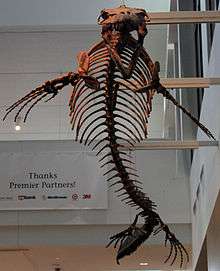Mosasaurinae
| Mosasaurinae Temporal range: Late Cretaceous, 92–66 Ma | |
|---|---|
 | |
| Mounted skeleton of Mosasaurus conodon, Minnesota Science Museum | |
| Scientific classification | |
| Kingdom: | Animalia |
| Phylum: | Chordata |
| Class: | Reptilia |
| Order: | Squamata |
| Superfamily: | †Mosasauroidea |
| Family: | †Mosasauridae |
| Subfamily: | †Mosasaurinae Gervais, 1853 |
| Type species | |
| †Mosasaurus hoffmannii Mantell, 1829 | |
| Genera | |
The Mosasaurinae are a subfamily of mosasaurid marine lizards.
Russell (1967, pp. 123–124)[1] defined the Mosasurinae as differing from all other mosasaurs as follows: "Small rostrum present or absent anterior to premaxillary teeth. Fourteen or more teeth present in dentary and maxilla. Cranial nerves X, XI, and XII leave lateral wall of opisthotic through two foramina. No canal or groove in floor of basioccipital or basisphenoid for basilar artery. Suprastapedial process of quadrate distally expanded. Dorsal edge of surangular thin lamina of bone rising anteriorly to posterior surface of coronoid...At least 31, usually 42–45 presacral vertebrae present. Length of presacral series exceeds that of postsacral, neural spines of posterior caudal vertebrae elongated to form distinct fin. Appendicular elements with smoothly finished articular surfaces, tarsus and carpus well ossified." In his 1997 revision of the phylogeny of the Mosasauroidea, Bell (pp. 293–332) retained the Mosasaurinae as a clade, though he reassigned Russell's tribe Prognathodontini to the Mosasaurinae and recognized a new tribe of mosasaurines, the Globidensini.[2]
Genera referrable to the Mosasaurinae ("mosasaurines") have been found on all continents except Australia and South America. The lineage first appears in the Turonian and thrived until the mass extinction event at the end of the Maastrichtian. They ranged in size from one of the smallest known mosasaurs (Carinodens, 3–3.5 meters), to medium-sized taxa (Clidastes, 6+ meters), to the largest of the mosasaurs (Mosasaurus hoffamannii) reaching about 17 m in length. Many genera of mosasaurines were either piscivorous or generalists, preying on fish and other marine reptiles, but one lineage, the Globidensini, evolved specialized crushing teeth, adapting to a diet of ammonites and/or marine turtles.
Relationships
Cladogram of mosasaurs and related taxa modified from D.V. Grigoriev, 2013:[3]
| Mosasaurinae |
| |||||||||||||||||||||||||||||||||||||||||||||||||||||||||||||||||||||||||||||||||||||||||||||||||||
References
- ↑ Russell, D. A., 1967. Systematics and morphology of American mosasaurs. Peabody Museum of Natural History, Yale University, Bulletin 23.
- ↑ Bell, G. L. Jr., 1997. A phylogenetic revision of North American and Adriatic Mosasauroidea. pp. 293–332 In Callaway J. M. and E. L Nicholls, (eds.), Ancient Marine Reptiles, Academic Press, 501 pp.
- Gervais, P. 1853. Observations relatives aux reptiles fossiles de France. Acad. Sci. Paris Compt. Rendus 36:374–377, 470–474.
- ↑ Grigoriev, D. V. (2013). Redescription of Prognathodon lutugini (Squamata, Mosasauridae). Proceedings of the Zoological Institute RAS, 317(3): 246-261.
Further reading
- Kiernan, C. R., 2002. Stratigraphic distribution and habitat segregation of mosasaurs in the Upper Cretaceous of western and central Alabama, with an historical review of Alabama mosasaur discoveries. Journal of Vertebrate Paleontology 22(1):91–103.
- Williston, S. W. 1897. Range and distribution of the mosasaurs with remarks on synonymy. Kansas University Quarterly 4(4):177–185.